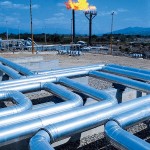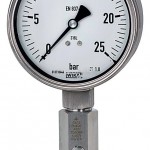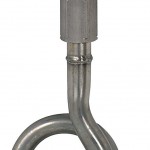In spite of the growing use of electronic solutions, mechanical pressure gauges are still present on the market for safe local display of process pressure without external power. Selecting and specifying the optimum measuring instrument is difficult for designers and users, in particular if it is to be used in extreme conditions such as vibrations, temporary overpressure, potentially explosive atmosphere, corrosive media or very high or very low temperatures.
Thomas Nieswandt
Strong vibrations can occur in the pipeline systems of complex plants or machines – for example due to the plant’s natural frequency. These external vibrations interfere with the measurement process of me-chanical pressure gauges and sometimes even damage the measuring instruments. Suitable measures must therefore be taken to prevent dynamic loads on an instrument’s mechanical components. The first choice should always be to fill the pressure gauge with liquid. Liquids dampen the motion of mechanical components – especially the movement and pointer – and reduce external vibrations. Another useful option is to mount the pressure gauge via a capillary. This flexible line prevents vibrations from being transmitted to the pressure gauge. To do this, however, the gauge must be decoupled from the plant. The measuring instrument can instead be attached to a wall, for example.
Problems for measuring systems are also caused by dynamic load cycles. These are produced, amongst other things, by the pressure impulses of a pump acting on the media to be measured. Pressure impulses can be recognised from the large pointer deflections and reduce the fatigue life of the elastic pressure element. However, they can be damped using a throttle that restricts the process connection. Alternatively, a snubber can be fitted to the pressure gauge. The gauge can additionally be filled with liquid. This acts as lubricant between the gauge’s moving parts and at the same time dampens the deflection of the bourdon tube, which is a consequence of the pulsating medium.
Overpressure can occur if the same pipeline is used for several processes with different media or if different gases are used subsequently in the same process. The system must be cleaned before changing the medium. This is normally done at considerably higher pressures than the usual process pressure. There are several options for protecting pressure gauges against overpressure. The use of a suitable measuring principle avoids the problem of “increased process pressure“ from the outset. Dia-phragm pressure gauges with a special membrane cover tolerate multiple overpressure, for example. Pressure gauges with a bourdon tube can be built to tolerate overload. A barrier is integrated in the gauge, which prevents further straightening of the tube. An overload protection device protects the measuring point against overpressure. The pressure gauge is additionally protected by a valve that allows the overpressure to be adjusted as demanded by the conditions of use: if the process pressure in the pipeline exceeds the set value, the valve closes automatically and protects the connected pressure gauge. If the pressure in the pipeline falls below a defined value, the overload protection opens and the pressure gauge indicates the line pressure. A third way is to use a shut-off valve: the valve is closed manually as and when necessary. After closing, a higher pressure is possible in the pipeline without damaging the pressure gauge.
Influence of temperature
The temperature – both medium and ambient – is a decisive factor when selecting the most suitable pressure gauge. These values determine the material that is used for the measuring system. If the temperature will exceed 60 °C, a system made of chrome-nickel steel is recommended. Such systems have a higher temperature stability compared to measuring systems made of copper alloy. The temperature also influences the type of connection between the measuring element and the process. The components of a measuring system made of copper alloy are soldered, whereas those made of chrome-nickel steel are welded in protective atmosphere. The second technique permits higher ambient and medium temperatures. In the case of chrome-nickel steel systems, measures to cool the medium are required at temperatures higher than 200 °C. It is advisable to use a pressure gauge syphon here. This is fitted directly to the pressure gauge and used as a cooling element. The condensate produced in the syphon also prevents the hot medium from coming into contact with the pressure gauge when pressure is first applied. At temperatures below 0 °C, pressure gauges filled with liquid are the best solution because they prevent icing of the moving components, e.g. the toothing of the movement.
Hazardous environments
The pressure gauges must also fulfil special requirements if they are to be used in areas with an explosion hazard. In this case, Atex Directive 94/9/EC applies. This Directive is binding both for pressure gauges with electrical accessories and for purely me-chanical gauges. With mechanical pressure gauges, for example, the static charges of the housing surfaces need to be considered. The Atex Directive is designed to protect persons working in hazardous areas. A pressure gauge manufacturer must guarantee that its products do not contain any potential sources of ignition. This demands various technical measures. For mounting a pressure gauge to Zone 0, for example, a flame arrester is welded into the pressure channel. It prevents sparks from entering the hazardous area if the pressure gauge breaks off above the male thread. If the medium to be measured is a corrosive substance, the material of the components in contact with this medium must be selected accordingly. Corrosion-resistant materials such as chrome-nickel steel or Monel (nickel-copper alloy) are suitable for pressure gauges with a bourdon tube, while Hastelloy, Tantalum and PTFE are ideal for diaphragm pressure gauges. In a corrosive environment, a corrosion-resistant PTFE or epoxy resin varnish should be preferred. Special attention must be paid to pressure gauges used for gases, such as acetylene or oxygen. Even at low pressure, oil or grease present inside the pressure gauge can ignite if in contact with pure oxygen. Effective measures must therefore be taken to avoid this kind of fouling – both when mounting the pressure gauge and throughout the production process. All relevant components must be cleaned using special procedures, for example. If acetylene is chosen, the process connection is restricted using a throttle in order to minimise the quantity of emerging gas in case of damage to the measuring instrument.
Hall 5, Booth 468
cpp 407
Pressure Gauge
Powtech 2008
Share:









